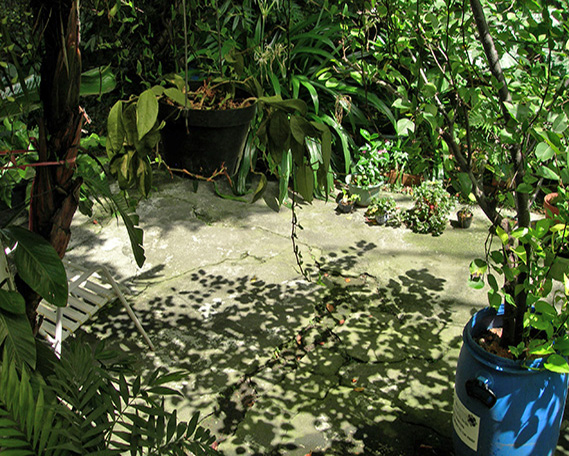My courtyard is a little place of everything. There was no planning or landscaping. I left it to the hands of nature. In the northeast and northwest corners, there is a big banyan tree respectively. They are so old and big that the Municipal Cultural Bureau has listed them as national property and issued a preservation order. Other plants such as gardenia, common jasmine orange and azalea are left from the time when the Japanese lived in the house. Underneath the trees, there are gainuwais, ferns and unknown vines whose seeds probably came with winds. Big and small potted plants dot the courtyard. They once belonged to different owners, and left here when the owners moved away. Over the years, the plants have found their comfortable place in the yard, casting various shadows as the sunlight moves slowly from one side to the other. In the morning and at dusk, birds such as turtle doves pay a visit to my courtyard and stay here a little while.

畫家舊居「老院子」實景、木屋平房的老畫室 董小蕙 攝 2008

院落中的花木光影 董小蕙 攝 2008

Old Trees in Courtyard 50 × 60.5 cm (12F) Oil on Canvas 1995 畫家第一件以「老院子」為題材的作品
The artist’s Courtyard series has its origins in the changes affecting her in her personal living environment. In early years, Taiwan had a large number of Japanese-style houses with courtyards, which contributed to fond memories for many people growing up then. After the 80s, due to the commercial needs of the rapid development of Taiwan’s urban centers, such houses were demolished and restructured en masse; this kind of destruction is a seemingly inescapable fate of the changing times. Thus, Tung wished to record a small piece of the cultural landscape and feeling of life of that time. The rustic charm of the various flowers and other plants casually growing in the calm courtyard, along with the light changing with the days and seasons, embody the kind of mood one cherishingly reminisces about.
In the beginning, the Courtyard series started with a style of impressionist sketching of surrounding scenery, but soon turned to a dazzling style emphasizing the effects of light and color. Tung studied and absorbed impressionism’s use of light and color over the last 10 years, and used expressive and fragmented brushstrokes to paint bright and beautiful sunlight, the tones and lights of the mood fitting the subtropics. Such color temperatures and light qualities are different from European geographic and weather features, and are part of the Taiwanese landscape and ambience. And thus Tung painted her own calm and ordinary life, and has authentically captured the plants and trees growing in the courtyard, the change of the seasons, and the feel of the interplay of light and shadow. Through this, she has also presented her own feelings toward the Courtyard.
Around 2005, the artist’s Courtyard series began to have a different change, from the fragmented brushstrokes of en plain air to a style of filling in large areas with broad strokes. At the same time, formerly bright colors turned into more deep and rich tones. The atmosphere of the Courtyard is still deeply moving, but the artist’s mood has already settled into a more implicit and reserved state. The development of an artist’s creative mood and style usually follows his or her life’s experiences gaining layer after layer. Shaw-Hwei Dong’s different phases of the Courtyard series are a clear example of where such a change is visible.

Early Summer in Courtyard 60.5 × 50 cm (12F) Oil on Canvas 2002

Togetherness 72.5 × 60.5 cm (20F) Oil on Canvas 2003

Pigeons in Courtyard 60.5 × 72.5 cm (20F) Oil on Canvas 2003

Serene Day in Courtyard 65 × 80 cm (25F) Oil on Canvas 2003